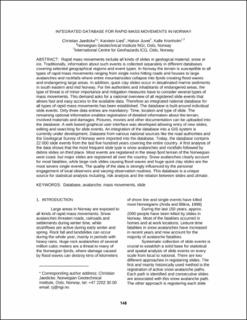| dc.description.abstract | Rapid mass movements include all kinds of slides in geological material, snow or
ice. Traditionally, information about such events is collected separately in different databases covering selected geographical regions and event types. In Norway the terrain is susceptible to all types of rapid mass movements ranging from single rocks hitting roads and houses to large avalanches and rockfalls where entire mountainsides collapse into fjords creating flood waves and endangering large areas. In addition, quick clay slides occur in desalinated marine sediments in south eastern and mid Norway. For the authorities and inhabitants of endangered areas, the type of threat is of minor importance and mitigation measures have to consider several types of mass movements. This demand asks for a national overview of all registered slide events that allows fast and easy access to the available data. Therefore an integrated national database for all types of rapid mass movements has been established. The database is built around individual slide events. Only three data entries are mandatory: Time, location and type of slide. The remaining optional information enables registration of detailed information about the terrain, involved materials and damages. Pictures, movies and other documentation can be uploaded into the database. A web based graphical user interface was developed allowing entry of new slides, editing and searching for slide events. An integration of the database into a GIS system is currently under development. Datasets from various national sources like the road authorities and the Geological Survey of Norway were imported into the database. Today, the database contains 22 000 slide events from the last five hundred years covering the entire country. A first analysis of the data shows that the most frequent slide type is snow avalanches and rockfalls followed by debris slides on third place. Most events are registered in the steep fjord terrain of the Norwegian west coast, but major slides are registered all over the country. Snow avalanches clearly account for most fatalities, while large rock slides causing flood waves and huge quick clay slides are the most severe single events. The quality of the data is strongly influenced by the personal engagement of local observers and varying observation routines. This database is a unique source for statistical analysis including, risk analysis and the relation between slides and climate. | en_US |
